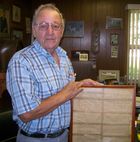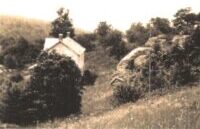In the Beginning – Denman Family line
I have decided to take the first 52 Ancestors challenge from Amy Johnson Crow’s list for 2025 and use it to write about the first ancestral family for each of my family lines this year. I am choosing to start with the Denman family line for two reasons. They are likely the most recent immigrants in any of my lines, having arrived in 1795. In addition, I was already thinking about writing about their home in upstate New York as I started thinking about writing about the homestead or family place back in September. So:
William Denman and his wife Ann Boorman Denman and their first three children emigrated from Hythe, Kent, England in 1795 landing first in New York City. William reportedly left the family there and traveled up the Hudson River to look at the land (200 acres) he had agreed to purchase sight-unseen.1 Although I have not yet found more exactly when they came or on what ship, I do have some evidence that the youngest child, a daughter named Elizabeth, died in New York City in August 1795.2 After that, Ann and the two boys went north to join William on their land.

The only time I saw the original indenture for the land was in the summer of 2011 when my sister and I visited the Neversink area of Sullivan county in New York and met some of the Denman family who were living there at the time. We got to see the original deed to the land, from 1795, as well as a musket said to have belonged to William originally. The original indenture had been found folded up in and envelope in a safe deposit box when its owner died in California. As the estate was being probated, it was returned to the Denmans still living in the Neversink area, and it was framed and proudly displayed on the office wall of the Denman Agency.
Two summers after our visit to Neversink, in 2013 I was fortunate enough to be located by a woman in New Jersey about a copy of the first indenture and whether I might want it. I wrote about that here. The short story is that she had acquired a photocopy of the indenture after Hurricane Sandy in the fall of 2012 had damaged the entire east coast of the U.S. with particularly severe damage in New Jersey where this genealogical angel was located. It seems that the owner of the original in California had made at least one photocopy for family members (likely more than one copy was made), and somehow this one had traveled across the country and landed in New Jersey. I was very happy to be able to take her offer, although the storm damage left the copy stuck to the glass of the frame.
On that trip to the Neversink area we learned about the William Denman family coming and taking possession of the property in late 1795, living first in a lean-to built against a large rock that provided a natural chimney. I wrote a post about visiting that site with two cousins and how difficult getting to the location was even in the present.
In a letter from Esther Boorman (wife of John Boorman and unknown relation to Ann) to Ann Billinghurst in December 17973 she described what she had been told about the Denman’s situation by a man who had been traveling in the “back country” of New York and had visited several English families including the Denmans. At the time of his visit, the Denmans were said to be living in a log house without a chimney. I suspect this was the first cabin they built replacing the lean-to and before they were able to build a house. Their situation was described as very difficult as they tried to clear their land. They had few resources, with no animals of their own, and had suffered a bad crop which left them with no bread and only the animal food they could catch. This meant that they had to plow, pull out stumps and rocks using only their own muscles and strength. In 1797, the Denman children (boys) were 6, 4, and less than 1 year old, so likely of little help with this hard work. Hunting and growing crops were the only sources of the family’s sustenance.

It isn’t clear to me when they were able to actually build a true house. There is a picture of the house, with a date of 1799 written on it, that shows the rock formation where the original lean-to had been (uphill from where the house was built). This date may have been a guess by one of my cousins about when the house was built. Over time the family persevered and thrived. The land was cleared and crops were produced. William and Ann produced a total of 11 children, 10 of whom survived to adulthood. The last eight were born in New York, likely in this house with the exception of Edward who was born in August 1797 (so would have been born in the cabin). Their first son, John, is my 3g grandfather.
The end of the story is that all the original Denman land and house were part of the decades-long process of building two reservoirs to provide water to the New York City water supply. Several of the small hamlets were taken and flooded in the process, destroying houses and requiring the removal of remains from cemeteries to be re-interred someplace else. William and Ann were among those, and their remains were re-interred in the Grahamsville Rural Cemetery.
__________
- Ackerley, Loretta (Compiler). “Township of Neversink 1798-1998”. Neversink, New York, 1998. ↩
- Finch, Jean (Transcriber). Transcription of a family Bible page belonging to George Erts of Tillson, NY of William Denman family births for a DAR application. Washington, DC, DAR Research Library, 1974. ↩
- Ackerley, Loretta (Compiler). “Township of Neversink 1798-1998”. Neversink, New York, 1998. ↩

I’d be happy to communicate about the Denman family line, do you know who your Denman grandfather’s parents or better yet grandparents were? Not all of the Denman family lines are related as far as I know, but we might be!
Saw this site today, thank you, as my Denman (born 1914) Grandfather married Grandmother Cuculic (born 1915).
Both passed in Angelina County TX.
Might you have more to share, which much gratitude?